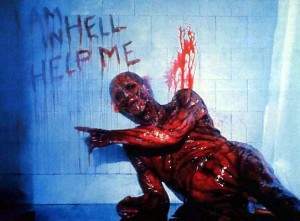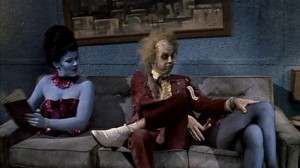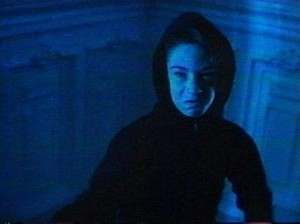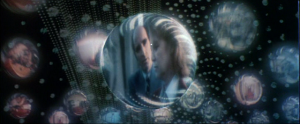
THE greatest unanswered question of human life is, paradoxically, about death.
What follows our duration on this mortal coil?
Do we queue up for an eternity of torment and suffering, or for a span of joy and love?
Is our “final destination” simply oblivion, the blinking out of everything that we know and are? Or are we reincarnated here on Earth to go through it all again?
On a very basic level, all horror movies obsess upon the issue of death, or perhaps, more accurately, the struggle to avoid and evade death; to survive and endure in the face of serial killers, vampires, werewolves, aliens and other boogeymen.
But some horror movies also determinedly obsess on the nature of what might come next, on the Great Beyond. Such films imagine visions of what life beyond this mortal coil could look like, and these strange, imaginative phantasms run the gamut of possibilities
The following six films are organized below, in ascending order, from domains of suffering and pain to ones of cosmic transcendence.
In other words, if taken in this order, these half-dozen genre films depict a cinematic stairway to Heaven. Climb it at your own risk.

Step One: The Realm of Suffering and Torment. Hellbound: Hellraiser II (1988)
In this sequel to Clive Barker’s Hellraiser (1987), the young heroine, Kirsty (Ashley Laurence) undertakes an Orpheus-like journey to the Underworld. She does so, in part because she has received a bloody message from a specter she assumes to be her dead father, written in scarlet blood. It reads: “I am in Hell. Help Me.”
Using a puzzle-box called the Lament Configuration, Kirsty discovers that the message’s source is not her father at all, but her sex-obsessed, deceased Uncle Frank. She finds Frank’s prison cell in Hell and learns that his everlasting torment is based on his particular foibles in life.
Specifically, he lives in a candle-lit room surrounded by altar-like slabs. Upon these slabs lay writhing, voluptuous, apparently sexually-available women. These female figures are shrouded beneath opaque curtains. But when the curtains are removed, the women disappear.
This Tantalus-like torment — to be teased with hunger and then to never have that appetite sated — represents Frank’s unending punishment for his misdeeds during life. “They always promise, but never deliver,” Frank describes mournfully.
In fact, Frank reveals that he summoned Kirsty — the Hellish equivalent of ordering take-out, I suppose — in the (vain) hope that she would willingly satisfy the physical desires that the disappearing ghosts would not. She doesn’t do so, and leaves him to his torment.
In a fashion, the Underworld as portrayed in Hellbound is not entirely unlike the one described as the Second Circle of Hell in Dante’s Divine Comedy. There “carnal malefactors” were punished for their lust, much like Frank is.
In addition to Frank’s private Hell, Hellbound also reveals the full breadth of the Hellish domain. The Labyrinth is an endless, Escher-like maze. And above that maze stands a malevolent, dark force that sees all: Leviathan.
Thus Hellbound offers a traditional view of Hell, one where a dark master punishes sinners for all eternity, and there is no escape for doomed souls.

Step Two: The Realm of Indifferent Imprisonment. Insidious (2011) and Insidious: Chapter 2 (2013).
James Wan’s horror film Insidious and its 2013 sequel depict “The Further,” a realm of spirits or souls that may also be reached via out-of-body experiences, or astral projection. But make no mistake this realm is the final destination for those who have died.
“The Further” is depicted in fascinating visual terms as a world where the energy and light we associate with life is absent.
Accordingly, “The Further” is half-lit, much like a movie projected on a screen through a rapidly darkening bulb. The souls that live here inhabit dark houses surrounded by impenetrable darkness. They are half-alive, and half-dead too. At times they seem frozen, or in stasis. But like juggernauts, they can also come to menacing life at any moment.
There may be something like “a better place” beyond “The Further” according to Insidious’s sequel, but it has not yet been depicted in the franchise. Trapped souls can also, if they are lucky, exit “The Further” to any location, past or present, from their mortal lives.
So this depiction of the after-life features an escape hatch, if one is only lucky enough to find it.
What “The Further” diagrams, then, is a realm where the joy and pain — and the light and energy — we now enjoy on Earth are gone forever. It is like a world functioning on minimum life-support, enduring…but at the lowest ebb imaginable.
At least here, unlike the Labyrinth of Hellbound, however, there is no sign of a controlling demonic authority, or Ultimate Evil. Instead, this place is like the Phantom Zone, not really a place for life at all.
“The Further” is the absence, even, of that horrible companionship.

Step Three: The Department of Eternal Bureaucracy. Beetlejuice (1987)
Tim Burton’s anarchic comedy, Beetlejuice imagines the after-life as a large, out-of-control bureaucracy. Newly dead souls arriving in this domain have no idea how things work there while unscrupulous souls, like Beetlejuice (Michael Keaton) game the system to their benefit.
And yes, this depiction of the after-life is likely a metaphor for the modern technological welfare state. Law-abiding folks get caught in the grinding gears of paperwork while scoundrels detect the loop-holes and exploit them mercilessly.
Beetlejuice involves a recently-dead couple — the Maitlands (Geena Davis and Alec Baldwin) — coming to the after-life and, simply, not understanding the rules of the game. Although they are given a handbook for ghosts, it resembles a “stereo instruction manual” and is largely unhelpful. When the Maitlands need their questions answered personally, they are forced to take a number in a large waiting room, with many other freshly-dead individuals also going through the never-ending queue.
In Beetlejuice, then, the after-life is as absurd, irritating and unfair as the life here that preceded it. This vision of the after-life isn’t overtly terrifying or painful so much as it is an unending pain-in-the-ass.
But the intricate layers of Bureaucracy also suggest that there is no one minding the store. No God, and no Devil. Either that, or they simply aren’t paying attention to the “little” people.

Step Four: The Null Zone, the Realm of Non-Corporeality and Pure Energy. Poltergeist II: The Other Side (1986).
Welcome to the vortex.
In Brian Gibson’s sequel to Tobe Hooper’s hit 1982 film Poltergeist, the imperiled Freeling family must defeat the evil Reverend Kane (Julian Beck) in what seems like neutral territory…”The Other Side” of the sequel’s title.
This is a realm that was seen as mostly neon strobe lighting in the first film, a visual flourish that knowingly reflected the blue light of static playing on a television, since the boob tube was the portal to Evil.
But here, in the sequel, the Freelings cross into a vast, substance-less dimension of swirling energy and light, where nothing beyond “void” seems to exist, at least at first. The family ultimately confronts Kane here, in his true, horrible form — a kind of multi-headed monster — but it is saved by the arrival of an angel, the family’s deceased grandmother (Geraldine Fitzgerald).
In this case, the immediate after-life looks a lot like the Mutara Nebula from Star Trek II: The Wrath of Khan (1982), a place of energy discharges and gas clouds. The presence of both Evil and Good in this ether-like medium suggests that another dimension exists beyond this one, but again, we don’t get to see it.
Perhaps this realm of non-corporeality and energy — this null zone — is the membrane that surrounds our world, and protects it from the worlds/dimensions beyond. But it is clear in Poltergeist: The Other Side that both good and evil can enter and exit this neutral realm, and that it is a jumping-off to other places.

Step Five: The Realm of Self-Knowledge. Flatliners (1990)
This 1990 Joel Schumacher film suggests that when we die, our souls travel to a realm where our morality is judged by a Divine Being (or mechanism).
So if you have done bad things here on Earth, you will be faced with that behavior in the next life. You don’t want to be found wanting, because what awaits you in eternity is the residue of your guilt, played out before your eyes over and over again, and sometimes violently so.
If you don’t make amends during your lifetime, suggests Flatliners, you will be tortured by what “you did” forever and ever. The specific avatar for revenge in the film is a little boy wearing a hoodie, Billy Mahoney. Watch out, because he swings a mean hockey stick….
In terms of narrative, Flatliners concerns a group of five medical students who undertake an experiment to “die” for short intervals, so as to view what comes next. When life slips away, the students then undertake emergency measures to “revive” the subject.
But before that medical resuscitation occurs, the characters each travel into a fantasy or nightmare realm. These journeys start as picturesque sojourns. We see soaring images of mountaintop summits and other natural wonders. But then the visions become suited to their percipients, determinedly reflecting memories of bad deeds, or feelings of guilt and shame.
Shot in autumnal hues of apricot and orange, Flatliners concerns, basically, Sin Personified. “We brought our sins back, physically,” suggests Keifer Sutherland’s character, Nelson. But the Evils brought back from beyond the mortal coil are also helpful to the beleaguered character in the sense that they lead to the important quality of self-knowledge, and the opportunity for a course correction.
Kevin Bacon’s character, Lobraccio, for instance, seeks out a woman that he once ceaselessly tormented in school. Once he finds her, he apologizes for his behavior. Nelson has a much harder time with that lesson, in part because his sin is greater. As a child, he accidentally killed the aforementioned Billy Mahoney. How can you make amends to someone who is no longer here?
Is saying “I’m sorry” enough?
Flatliners imagines that beyond our life here, the only important question is how you lived. And it’s never too late to be better.

The Final Step: The Realm of Transcendence. Brainstorm (1983)
In Douglas Trumball’s Brainstorm (1983), a scientist named Lillian Reynolds (Louise Fletcher) uses a miraculous new device that can record brain impulses…just as she is experiencing a catastrophic and terminal heart attack.
The images of Lillian’s death experience are thus recorded on a copper, film-like “tape,” but Lillian’s recording remains unseen until the film’s climactic moments.
Finally, after many travails, Reynold’s research partner, Michael (Christopher Walken) uses the same device and screens the tape. In doing so, he receives a final answer about what lies beyond the limits of this life.
At first the picture is not pretty. For a moment, we see people writhing in pain, trapped in fleshy, lumpy, organic bubbles. Is this Hell? Or a representation of how our souls are trapped in our physical bodies?
Very quickly, this grotesque phantasm is left behind, and the camera — representing Lillian’s soul — leaves Earth behind. We watch as the camera takes us far away from our solar system, to the furthest point in cosmic space, perhaps.
There, Lillian joins a group of angel-like butterfly organisms — representations of the soul — as they move towards a warm and welcoming light, the well-spring or fountain of all life itself, perhaps.
Through Lillian’s experience, we see that there is nothing to fear in death, and that the after-life is a realm of transformation. Once we die, we are not human anymore. Instead, we are one with the cosmos itself, and with each other.

Ian Fleming once wrote that we only live twice: once at birth, and once looking death square in the face.
By imagining so many variations of the after-life — from the torments of Hell to the serenity of cosmic “oneness” — the preceding six films have indeed stared death in the face.
Let’s all hope that if there is a Great Beyond to grapple with, it’s more Brainstorm and less Hellbound.
Would you like to support Flashbak?
Please consider making a donation to our site. We don't want to rely on ads to bring you the best of visual culture. You can also support us by signing up to our Mailing List. And you can also follow us on Facebook, Instagram and Twitter. For great art and culture delivered to your door, visit our shop.








